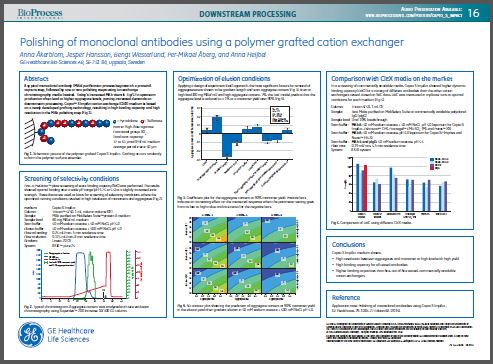- Sponsored Content
- Downstream Processing
Polishing of Monoclonal Antibodies Using a Polymer Grafted Cation Exchanger
November 10, 2014

Sponsored by GE HealthCare Technologies
A typical monoclonal antibody purification process begins with a protein A capture step, followed by one or two polishing steps often using ion exchange chromatography media. This poster presents how to use the new cation exchange chromatography medium, Capto™ S ImpAct in MAb polishing. Capto S ImpAct is based on a newly developed grafting technology (Figure 1), resulting in high binding capacity and high resolution.
To find the optimal conditions for static binding capacity of a MAb a screening was done using PreDictor™ 96-well plates. When the optimized running condition was used it resulted in high resolution of monomers and aggregates (Figure 2).
A comparison of different cation exchangers on the market is presented. Two different MAbs are used and one of them has been run at two different conditions. When using these antibodies and conditions, Capto S ImpAct showed the highest binding capacity in all runs (Figure 5).
The conclusions are that Capto S ImpAct medium shows:
High resolution between aggregates and monomer at high load and still keeping high yield
High binding capacity for all tested antibodies
Higher binding capacities than five, out of five tested, commercially available cation exchangers
About the Author(s)
You May Also Like





